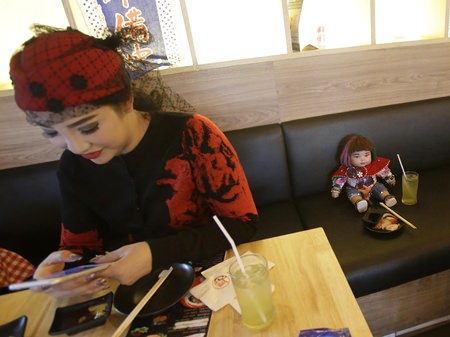Bangkok (AP) – Mix one part superstition, two parts fashion, a dab of celebrity idolatry and a heap of media frenzy, and what do you get? “Child angel” dolls, the latest craze in Thailand.
The dolls occupy a niche somewhere between Buddhist amulets, beloved by gamblers, gangsters and policemen for their reputed magical protective powers, and Furby toys, adored by children for their cuteness.
The adults who own them affirm that “child angel” dolls will bring you good luck, especially if you treat them like your own living progeny, taking them on trips, treating them to meals and praying together at the temple.
 Supavadee Tapmalai uses her smartphone next to her “child angel” doll after offering it food at a Japanese restaurant in Bangkok, Friday, Jan. 28, 2016. The doll phenomenon has been analyzed as a modern version of a traditional totem containing real body parts, but as a fad it seems have more in common with Furby dolls. (AP Photo/Sakchai Lalit)
Supavadee Tapmalai uses her smartphone next to her “child angel” doll after offering it food at a Japanese restaurant in Bangkok, Friday, Jan. 28, 2016. The doll phenomenon has been analyzed as a modern version of a traditional totem containing real body parts, but as a fad it seems have more in common with Furby dolls. (AP Photo/Sakchai Lalit)
While “luk thep” dolls, as they are known in Thai, previously drew only mild notice beyond the circle of their devoted collectors, attention skyrocketed this past month after a leaked memo from budget airline Thai Smile instructed staff to treat the dolls like human passengers – provided, of course, their seats were paid for.
The airline noted the creepiness factor, suggesting the dolls be seated out of sight as much as possible.
In short order, several restaurants announced similar doll-friendly policies. Police, meanwhile, warned the dolls could be used to smuggle drugs and busted one (in Chiang Mai – story at www. chiangmai-mail.com) with 200 hidden methamphetamine tablets.
The dolls have been specially blessed by some Buddhist monks, who apply sacral markings to them, as they might with a new car or house. It’s not a strictly Buddhist practice, and at least one temple reportedly banned the doll blessings, but easygoing Thais aren’t fussy about blending Hindu ritual and other elements into their religion.
The dolls, mostly imports, cost anything from a few hundred baht up to tens of thousands of baht, with the blessings available on a similar sliding scale. Some are customized by sellers, and owners invariably gussy them up, with jewelry and other accessories, in anticipation of, or thanks for, good fortune.
The dolls have elements of a hobby, a cult and a business. Mental health authorities, while cautioning against superstitious practices, acknowledge their therapeutic utility as stress reducers.
Kanuengnit Chotichanachaiphat, 31, adopted her first doll two years ago on the recommendation of a friend who said it would bring her luck, and named it “Pa Ruay” (“Being Wealthy”). Kanuengnit, with part-time jobs as an events hostess and golf caddy, believes Pa Ruay helped increase her income just three months after she adopted him.
Now she has five dolls, and enjoys doing their hair so much she does hair modifications on other people’s dolls for 800-1,000 baht apiece.
The dolls provide some of the same satisfactions as a pet – minus the messiness – but it is their supernatural aspect that draws more attention and debate.
Aside from the awkwardness of carrying them around in one’s arms, they have much in common with traditional Buddhist amulets – coin-sized talismans with supposed magical powers that are usually worn around the neck.
Amulet collecting is a popular but old-fashioned hobby. Dolls are more popular with a younger, urban crowd, including celebrities.
It has been suggested that the dolls also have more macabre associations, or at least antecedents.
An ancient black magic rite known as “kuman thong” in its purest form involves taking a stillborn human fetus, drying it over a fire, and coating it with gold leaf. More commonly, the rite is reputed to merely contain a body part, but like luk thep, they are believed to be imbued with a child’s spirit.




